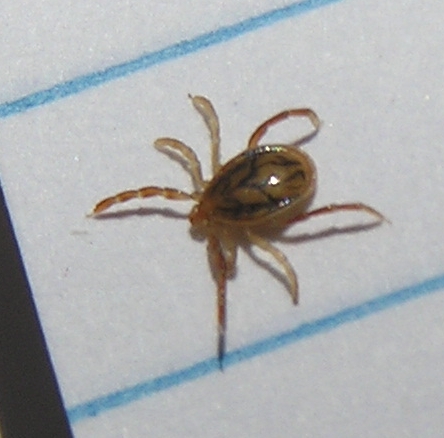- Paralysis tick
Taxobox
name = Paralysis tick

image_width = 250px
regnum =Animal ia
phylum =Arthropod a
classis =Arachnida
ordo =Acari
familia =Ixodidae
genus = "Ixodes "
species = "I. holocyclus"
binomial = "Ixodes holocyclus"The paralysis tick, "Ixodes holocyclus", is one of about 75 species of
Australia ntick fauna and is considered the most medically important. It is found in a 20-kilometre band that follows the eastern coastline of Australia. As this is where most people live, incidences of tick bites on people, pets and livestock are relatively common. Although most cases of tick bite are uneventful in humans, some can result in fatal illnesses including paralysis,tick typhus and severeallergic reaction s. The tick's paralysing toxin has been estimated to affect as many as 100,000 domestic animals annually, with up to 10,000 companion animals being referred to veterinary surgeons for treatment. Up to 1989, 20 fatal cases have been reported in Australia. [cite journal
author = Masina S, Broady K. W.
title = Tick paralysis: development of a vaccine
journal = International Journal for Parasitology
volume = 29
issue = 4
pages = 535–541
year = 1999
doi = 10.1016/S0020-7519(99)00006-5]Removal
The best method of removal uses a pair of tweezers to pull the tick off as close to the skin as possible. Methods involving spreading butter or oil over the tick are not advised. However, removal with tweezers can stimulate the tick to inject more toxin if not performed correctly. It is advisable to avoid squeezing the main tick body by using an angled pair of tweezers which will grip the head region close in to the skin. Specialised tick removal tools are inexpensive and highly recommended in areas where ticks are prevalent. [cite journal | author=Needham GR | title=Evaluation of five popular methods for tick removal | journal=Pediatrics | year=1985 | volume=75 | pages=997–1002 ]
External links
* [http://www.tickalert.org.au/ixholdet.htm Tick alert support group]
* [http://medent.usyd.edu.au/fact/ticks.htm University of Sydney Department of Medical Entomology: about ticks]References
Wikimedia Foundation. 2010.
